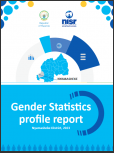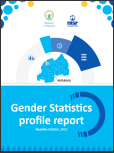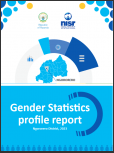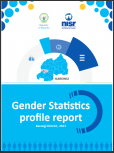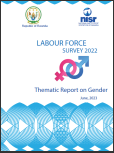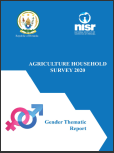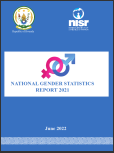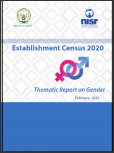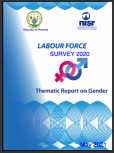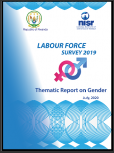Gender Statistics profile report- Nyamasheke District, 2023
This is the second edition of the Gender Statistics District Profile Report, which provides updated sex-disaggregated data across key areas such as poverty and social protection, education, health, violence against women, the economy, decision-making, ICT and media, and the environment. These areas are classified under the National Strategy for Transformation (NST1) pillars: Economic Transformation, Social Transformation, and Transformational Governance.
Gender Statistics profile report- Nyabihu District, 2023
This is the second edition of the Gender Statistics District Profile Report, which provides updated sex-disaggregated data across key areas such as poverty and social protection, education, health, violence against women, the economy, decision-making, ICT and media, and the environment. These areas are classified under the National Strategy for Transformation (NST1) pillars: Economic Transformation, Social Transformation, and Transformational Governance.
Gender Statistics profile report- Ngororero District, 2023
This is the second edition of the Gender Statistics District Profile Report, which provides updated sex-disaggregated data across key areas such as poverty and social protection, education, health, violence against women, the economy, decision-making, ICT and media, and the environment. These areas are classified under the National Strategy for Transformation (NST1) pillars: Economic Transformation, Social Transformation, and Transformational Governance.
Gender Statistics profile report- Karongi District, 2023
This is the second edition of the Gender Statistics District Profile Report, which provides updated sex-disaggregated data across key areas such as poverty and social protection, education, health, violence against women, the economy, decision-making, ICT and media, and the environment. These areas are classified under the National Strategy for Transformation (NST1) pillars: Economic Transformation, Social Transformation, and Transformational Governance.
Labour Force Survey 2022, Thematic Report, Gender
This report is the result of the analysis of Labour Force Survey 2022. It sets out a broad overview of trends and gender gaps, including gaps in labour force participation rates, employment-to-population ratios and unemployment rates, along with differences in labour market status and the type of activities that men and women perform in the labour market, hours spent in paid and unpaid work and sectoral and occupational segregation. It also discusses the extent to which these factors account for gender gaps in wages and social protection.
Agriculture Household Survey - 2020(Gender Thematic Report)
This report presents the results of the Agricultural Household Survey carried out from 6th September to 8th October 2020 taking into account gender aspects. The information enclosed in this report covers agricultural activities done in the 2019/2020 agricultural year.
National Gender Statistics Report 2021
The 2021 National Gender Statistics Report provides the updated sex-disaggregated data in twelve fields: Population and Youth; Education; Health and Nutrition; Economic Activity and time use; Poverty & Social Protection; Justice & Human rights; Environment and Natural Resources; Decisionmaking and Public life; Infrastructure, ICT and Media; Trade and Business and Industry; Agriculture, Livestock and Forestry, and lastly the Income and Access to Finance.
Establishment Census Report, 2020 - Thematic Report on Gender
The Establishment Census is a valuable source of information on all economic activities by size, formal and informal status of establishments in Rwanda. It provides information that is used to classify establishments according to their size (micro, small, medium, and large) but also formal and informal establishments. The methodology used for data collection and data analysis is quite similar and this helps in comparative analysis with the previous establishment censuses.
Labour Force Survey 2020, Thematic Report, Gender
This report is the result of the analysis of Labour Force Survey 2020. It sets out a broad overview of trends and gender gaps, including gaps in labour force participation rates, employment-to-population ratios and unemployment rates, along with differences in labour market status and the type of activities that men and women perform in the labour market, hours spent in paid and unpaid work and sectoral and occupational segregation. It also discusses the extent to which these factors account for gender gaps in wages and social protection.
Labour Force Survey 2019, Thematic Report, Gender
This report is the result of the analysis of Labour Force Survey 2019. It sets out a broad overview of trends and gender gaps, including gaps in labour force participation rates, employment-to-population ratios and unemployment rates, along with differences in labour market status and the type of activities that men and women perform in the labour market, hours spent in paid and unpaid work and sectoral and occupational segregation. It also discusses the extent to which these factors account for gender gaps in wages and social protection.

